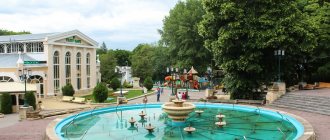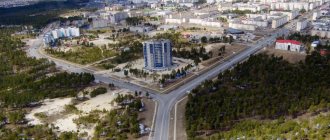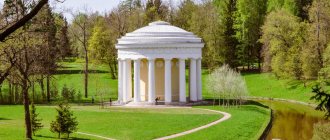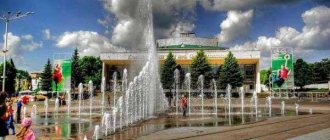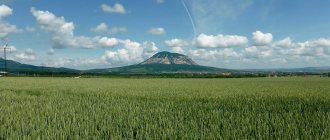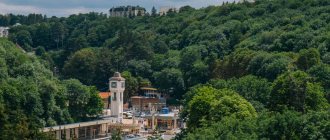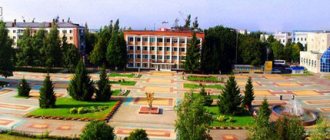The changes that have occurred in the world over the past year and a half have forced us to reconsider our views on many things, including travel. During the time when traveling abroad was unavailable to us, we learned to discover beauty nearby. Closed borders inspired us to get to know our country and its incredible, diverse spaces better. On November 4, Russia celebrates a national holiday - National Unity Day: an excellent occasion to learn something new about the country and look for the next interesting location for travel. We already have one in mind for you: the city of Essentuki - the birthplace of the famous mineral water, a real treasure given to us by the nature of the Caucasus.
We have collected the most interesting facts about the legendary resort city and the equally legendary Essentuki mineral water, which celebrates its 150th anniversary this year.
A few facts about Essentuki
- The name of the city was given by the name of the local nobleman Essen, who lived in these areas during the era of the Golden Horde. He was buried here, on the Essen-Tuk hill, located on the left bank of the Bolshaya Essentuchek River in a specially built mausoleum. Now little remains of the structure, but some of its fragments are kept in the local history museum.
- The official date of formation of Essentuki is considered to be 1825. The base for it was a small fortification of the Volga Cossacks, built several decades earlier.
- The first mineral springs were discovered here by the very Cossacks who served as commandant in the region. It was they who noticed the unusual streams flowing into the small river Kislusha.
- The first to explore and describe the mineral springs of Essentuki was Professor A.P. Nelyubin. The doctor of medicine's list included 20 sources, and he assigned a serial number to each of them.
- The first vacationers appeared in Essentuki in 1835. By this time, the city had acquired several baths, which were supplied with water from nearby mineral springs.
- Russians began to show real interest in the resort at the beginning of the 20th century, when several hydropathic clinics and specialized sanatoriums were built in these places.
- After the end of the civil war, in the 1920s, Essentuki was given the status of a resort town, and Soviet citizens began to come here en masse for treatment and recreation.
- The population of Essentuki is 114.8 thousand people.
- The distance to the capital of the region, Stavropol, is 200 km.
- Essentuki is located between Pyatigorsk and Kislovodsk, the distance to these resorts is about 23 km.
Essentuki Railway Station
Address: Essentuki, Vokzalnaya st., 1A.
The historic railway station building at Essentuki station was built in 1893 in the Old Russian style. The station is located in the city center, next to the Resort Park. Long-distance trains and commuter trains arrive at the station. In 1957, a 14-meter obelisk Eternal Glory was erected on Station Square at the burial site of 11 people who died at the hands of the White Guards.
Internationalnaya Street, the former Main Kursovaya, begins from Station Square. Walking along it, you can see interesting old villas, hotels and mansions.
Relevant products in the Online store:
Kérastase
SPECIFIQUE Thickening spray against hair loss and thinning hair
RUB 4,833 RUB 5,370
GUAM
UPKER Intensive therapy against hair loss
RUB 2,302 RUB 3,070
MBR
PURE PERFECTION 100N HAIR & SCALP BOOSTER Intensive care to nourish the scalp and hair
RUB 11,625 15,500 rub.
SEPHORA COLLECTION
Hair Serum Strengthening and thickening hair serum
from 1,488 rub.
exclusive
All goods
theatre square
While viewing the sights of Essentuki, you cannot pass by the central square of the city, called Teatralnaya. This place got its name from the huge concert hall named after Chaliapin, which in former years was called the Touring Theater. In addition to the theater, there is a large department store on the square - a real Mecca for those who like to shop. There is also a stage where various celebrities perform in the summer.
Along with the concert hall and department store, Teatralnaya Square in Essentuki is decorated with another attraction - the singing fountain. It is considered one of the largest and most beautiful fountains in the southern part of Russia. It is located right in front of the stage, and is made in such a way that water flows directly from under the asphalt.
The area of the fountain is about 400 square meters. m. It is not fenced in anything, so children love to run around it, dodging powerful vertical water jets that erupt every minute from pipes hidden under the asphalt. In the evenings, a light and music accompaniment is turned on at the fountain, which creates a real show that attracts many spectators.
Concert Hall named after Chaliapin in Essentuki
Among the attractions of Essentuki there is a very interesting structure - this is the Chaliapin Concert Hall. It is located in the city center opposite the main entrance to the Essentuki healing park. Look at the photos and videos. The concert hall hosts various events, as well as famous artists and theater groups. The concert complex opened in 1980 and exists to this day. The complex includes two halls, large and small. The large hall has a capacity of 1,500 seats, the small hall has only 80 seats. The stage of the large hall of the Shalyapin concert complex in Essentuki has a complex design and allows performances of various genres and unusual bright shows to be held there. If you are relaxing as a tourist in Essentuki, be sure to visit the concert hall, which is located at 2 Kislovodsk Street.
Concert Hall named after Chaliapin in Essentuki
Sanatorium Victoria
Sanatoriums in Essentuki
Zero kilometer of love
Address: Essentuki, International street.
The sculpture under the unusual name “Zero Kilometer of Love” was created relatively recently, in 2011, and immediately gained popularity among beloved couples and newlyweds. The former make dates here, and the latter come after the formalization of the relationship to take beautiful photographs.
“Zero Kilometer of Love” is a stele on top of which stands Cupid, in the original version he was sleeping. At the base of the sculpture are two shiny metal hearts, symbolizing love and fidelity.
Theater Park
The Essentuki Theater Park looks very attractive. In appearance, it looks like a typical park pavilion of the late 19th century: a classically shaped building with high panoramic windows and light-colored facade decoration. Previously, all kinds of visiting performers actively performed on its stage. Now the profile of the structure has changed somewhat. The theater-park building houses a hotel and a restaurant with a banquet hall.
Resort Park
The Spa Park is located directly opposite the train station. If you list the attractions of Essentuki, then this place on the list should take the very top line. The park area appeared back in 1848, and since then it has always enjoyed enviable popularity.
Here you can simply walk along the shady alleys, drink mineral water, and hand-feed the squirrels, who are accustomed to people. Due to the fact that the Resort Park has a very large area, a plan diagram has been installed at its entrance to help you navigate its territory more easily.
Near Essentuki
The surrounding area of the city is full of amazing places around which there are many legends. For example, Ring Mountain with natural arches that bring good luck, Mount Mashuk with its underground lake and the observation deck “Aeolian Harp” and Honey Falls in the gorge of a mountain river.
In half an hour by train from Essentuki you can get to Pyatigorsk or Kislovodsk. Well, if time permits, then in a few hours you can get to the foot of Elbrus and see the places where Essentuki mineral water is born. Along the way you will find majestic landscapes, winding mountain rivers, waterfalls of the Djily-Su tract and colorful settlements.
Source #17
The oldest drinking gallery of spring No. 17 was built in the English style in 1848 according to the design of the famous architect Samuel Upton. The pump room is located next to the side of Theater Park. Here you can try the most famous mineral water of Essentuki - No. 17 - for free. Medicinal water has contraindications; you should consult your doctor before drinking it.
Musical gazebo
But the attractions of Essentuki are not limited only to large architectural objects. There are also several small but very attractive buildings in the city, for example, the musical gazebo in the Resort Park.
The gazebo is a tall octagonal pavilion made of cast iron. Its history dates back to 1879, when the first concert took place. The city brass band, located in the gazebo, played popular tunes for park visitors. Gradually this became a tradition, and a brass band still plays here from May to September.
What to see in Essentuki
Typically, tourists come to Essentuki to improve their health: drink local mineral water, undergo treatments with healing mud, take healing baths - and all this is surrounded by magnificent ancient architecture and the fertile nature of the Caucasus. Wooded slopes, snow-capped peaks, blue lakes - Essentuki is much quieter and calmer than other popular cities of the Kavminvod, for example, Kislovodsk and Pyatigorsk, in these places you can relax both body and soul.
The main city attractions are located in the Resort Park, the history of which began in 1847, when Count Vorontsov decided to green the Essentuki resort. His idea quickly came to fruition, and already in 1849, seedlings of trees and shrubs from the Tiflis Botanical Garden and Warsaw nurseries began to be imported to Essentuki.
And last spring, a large-scale restoration was completed here: specialists recreated the walking alleys according to the original historical plan of Prince Vorontsov. The huge park, where noble trees of rare species grow, is decorated with thousands of flowers. Even in autumn and winter, when the fountains “sleep” and the summer riot of colors gives way to a brooding naked landscape, there are many picturesque corners for walks and photo sessions: grottoes, cascades, romantic gazebos, buildings of the Lower and Upper Baths and much more.
The architecture of the city is especially worth noting. Essentuki is a real paradise for fans of antiquity and modernity: quiet streets and shady alleys are full of treasures hidden from view by tall trees. For example, the Essentuki railway station is one of the oldest in the country. If you walk from the station to Teatralnaya Square or along Andzhievsky Street and the adjacent streets, you can see many unique houses of the late 19th and early 20th centuries.
The famous building of the mud baths named after N. A. Semashko resembles an ancient temple in its beauty and grandeur. A bathtub made of Italian marble has been preserved here since Tsarist times; it can be used for treatments with healing mud and mineral water. Essentuki is also home to Europe’s largest drinking gallery, “Pyatysyachnik”.
However, local attractions and entertainment are not limited to sanatoriums, drinking galleries and medical procedures. For example, the F.I. Chaliapin Concert Hall is famous for its unique organ.
Upper (Nikolaev) baths
The Nikolaev baths were built in 1898 according to the design of the architect N.V. Dmitriev, named in honor of Emperor Nicholas II. Here, those who wished not only took mineral baths, but also practiced mud therapy. After the mud baths were built, only balneotherapy was carried out in the Nikolaev baths. Upper baths have retained their functionality to this day.
Baths of Emperor Nicholas II
The second popular medical attraction of Essentuki is the Bath building of Emperor Nicholas II, located in the Medical Park. During the reign of Nicholas II, mud and mineral baths were very popular; for this reason, the construction of Therapeutic Baths began in 1895. They received their first visitors even before they were completed - in 1898.
The bathroom building was completed in classicism with minor baroque elements. Everything is very discreet and comfortable. In the center of the building there were pools for taking mud baths, and in winter, in the remote part, there were mineral springs. The Imperial Baths did not operate for long - after the opening of the Alekseevskaya mud baths, not a single medical procedure was carried out in this building.
From the moment of its construction to the present day, the building of the Imperial Baths has been rebuilt several times, as a result of which it has become impossible to see the original appearance of the structure. These reconstructions were carried out with only one purpose - to make medical procedures available all year round in Essentuki Park.
Today, while exploring the sights of Essentuki, guests can visit the Imperial Baths at any time to admire the decoration of the building, as well as take any of the 90 possible mineral and mud baths.
Baths of Emperor Nicholas II
Essentuki Baths of Emperor Nicholas II
Essentuki Baths of Emperor Nicholas II
bathroom photos
Essentuki Narzan spring No. 17
Church of Panteleimon the Healer
Address: Essentuki, st. Andzhievsky, 2.
The Cathedral of Panteleimon the Healer in the Resort Park was built in 1896. Many famous artists who vacationed in Essentuki came here: Maxim Gorky, Fyodor Chaliapin, Sergei Rachmaninov, Alexander Kuprin, Konstantin Stanislavsky and others. In 1935, the temple was blown up. In the 1990s, donations began to be collected for the restoration of the temple. The Church of St. Pateleimon was rebuilt and consecrated in 2021.
Related materials:
Essentuki | cities of Russia | wealth | A true legend | apparatus | illness | top | gazebo | water | luxury hair | healing mud | wildlife | clean air | mineral water | Alexander Kuprin | summer resort | clean water | resort | Caucasus
Articles
- KZ, or Abroad without a foreigner December 1, 2013, 19:00
- Enduring Values: Day of Family, Love and Fidelity July 08, 2015, 21:00
- National dishes. Chepalgash June 14, 2021, 14:00
Video
- Euphoria of summer with Kenzoki August 13, 2010, 00:30
- Summer in Capri style June 10, 2012, 19:25
- Exquisite summer makeup from MAC June 11, 2014, 15:00
Dacha "Eagle's Nest"
Address: Essentuki, st. Andzhievsky, 7.
It is impossible to imagine the sights of Essentuki without a small elegant building with turrets and balconies. This mansion once served as a summer residence for local police officer I.G. Zimin, who finished building his small palace in 1912. The building turned out to be very attractive indeed. Decorative stucco molding, arched ceilings, multi-format windows - all this gives the small three-story building a very attractive look.
The name “Eagle’s Nest” stuck to Zimin’s dacha due to the fact that on the facade there is a sculptural group in the form of three eagles sitting in a nest. When Soviet power came to Essentuki, the building was nationalized and a hospital was set up in it. Now the Eagle's Nest has been repurposed as a library.
Mud bath named after Semashko
Website : www.essbgl.ru Address: Essentuki, st. N.A. Semashko, 10. Opening hours: daily from 9.00 to 13.00, on Saturday until 12.30.
A significant part of the people who come to Essentuki go to one of the most beautiful and unusual buildings in the city - the mud baths named after. ON THE. Semashko. Despite the considerable age of the medical institution, which was built in 1915, it looks great. The architect of the building is Evgeniy Fedorovich Schretter, who won the competition for the design of the Essentuki mud baths. At first the hospital was called Alekseevskaya, in honor of the heir to the throne, Tsarevich Alexei.
The appearance of the mud baths indicates that no expense was spared on its construction. Figures of mighty lions, Ionic columns, colorful thematic bas-reliefs - all this is more reminiscent of the country residence of an ancient Roman senator than the building of a medical institution. At the entrance, visitors are greeted by the god of healing, Aesculapius, and his daughter, the goddess of purity, Hygieia.
About 2,500 procedures are performed here every day using the mud of the unique Tambukan Lake.
Mud bath
Many thousands of tourists come to the resort town of Essentuki to visit the Semashko mud baths. The building was erected in 1915 under the leadership of the young architect E.F. Schrötter.
Initially, the hospital was named in honor of the son of Emperor Nicholas II - Alexei. The building was distinguished by elegant, expensive decoration. It itself was built from stone mined in the vicinity of Essentuki. During the Civil War, the mud bath was seriously damaged and ceased to function. She received a second life thanks to the People's Commissar of Health Semashko, after whom she is named to this day.
Currently, tourists visit the mud baths for two purposes - taking therapeutic mud baths and studying amazing sculptures and bas-reliefs. Look at the video and photos. As an example, we can cite 2 sculptures of the ancient Greek Gods located at the entrance - Hygeia and Aesculapius. The interior decoration of the hospital also deserves close attention from vacationers.
Essentuki Mud Bath
Essentuki Mud Baths photo
Mud bath
stone lion
In the vicinity of Kislovodsk in the friendly republic of Karachay-Cherkessia, you can look at the Honey Falls, which amaze with their scale.
main entrance
Mud bath entrance with columns
Mud bath photo
panorama of the mud baths
entrance to the bathrooms
Victory Park (English Park)
Another park in Essentuki is named after Victory. It covers an area of about 40 hectares. What distinguishes it from other parks in the city is that its creators used the canons of the English park style, which is why it was originally called English. Another feature is the abundance of plants not found in the Caucasus. Dendrologists brought seedlings from other regions and grew them in local conditions.
The park received its modern name in honor of the “Eternal Flame” stele installed on its territory, which is dedicated to the soldiers and commanders of the Red Army who died during the Civil and Great Patriotic Wars.
Drinking gallery "Fivethousander"
It’s simply impossible to come to the resort and not visit the “Fivethousander” drinking gallery. Firstly, because this is the largest drinking pavilion in Europe. Secondly, 5,000 people can taste narzans there at the same time. Thirdly, the actual architecture of the drinking pavilion arouses keen interest among its visitors. While pump rooms with flowing water are located on the ground floor, art exhibitions are regularly held on the second floor.
And all this is complemented by greenery, sculptures and fountains. Around the gallery there are paved paths with benches and lanterns installed along them. And the narzans themselves, including the world-famous “Essentuki-4” and “Essentuki-17”, can be tasted cold, warm and hot.
From the history of Essentuki
The history of the city of Essentuki begins in 1798: in the first years of the reign of Paul I, a military border redoubt was founded here. Later, in 1803, the Essentuki Cossack post was left in its place, and already in 1825, by order of the Highest, the Essentuki village was founded on the Bugunta River.
A little later, active improvement of this territory begins: a railway is being laid, landscaping work is underway.
In 1892 According to the project of engineer Conradi, a water supply system begins to operate, supplying the resort with fresh water from drip sources from the Kapelny stream basin. And in 1898 electric lighting was introduced.
The area of old Essentuki, adjacent to the park from the west, is gradually turning into a beautiful, modern town with wide cobbled streets, fountains, squares and gardens around neat and clean houses.
Another no less important date for the resort town of Essentuki is considered to be 1871 - the year of the beginning of large-scale bottling of Essentuki mineral water. It was at this time that the first Razlivnaya opened on the territory of the Resort Park. “Essentuki No. 4” and “Essentuki No. 17” became one of the first mineral waters that began to be bottled and supplied to pharmacies in the largest cities of the Russian Empire and abroad. Since then, thousands of people in different countries have had the opportunity to enjoy the taste and benefits of Essentuki.
Temple complex Rio de Caucasus
Address: Essentuki, Borgustanskoe highway, 31.
There is a rather unusual and strange object in Essentuki; it is an amusement park with a religious twist. This is a huge temple complex of Peter and Paul, which is popularly called “Rio de Caucasus”. It received such an unusual name for the statue of Jesus Christ installed on its territory, which in appearance resembles the famous figure of the Savior from Rio de Janeiro. While inferior in size to its overseas counterpart, Christ of Essentuki is the tallest in Russia.
Rio de Caucasus was built with private funds on the site of a garbage dump, located on the outskirts of the city. In addition to the statue of Jesus with a chapel under it, the complex contains the Peter and Paul Church, many chapels, a mini-zoo, an exhibition of retro cars, a mini-zoo, a children's playground, as well as an alley with busts of ancient Greek philosophers Aristotle, Sophocles, Plato and others. At the entrance, visitors are greeted by sculptures of two trumpeting angels.
Essentuki. The Caucasus is in front of me
Essentuki is associated with mineral water, and few people know more about one of the four resorts of the Caucasian Mineral Waters. There are no mountains or “Lermontov places” in the city, which neighboring Kislovodsk and Pyatigorsk are rich in. And yet, it’s worth coming here not only for mineral water.
Text and photo: NIKITA KRIVTSOV
Mountains from the north and south
Today Essentuki is a pretty southern city, where the quarters of the old Cossack village and modern high-rise buildings are combined. The resort park is approached by areas of cottages, which, by the way, are very nice and not like the tasteless palaces of the Moscow region. Essentuki is a steppe and flat city, but to the north of it rises the five-domed Beshtau, the main peak of the Mineralnye Vody region. And to the south, the double-headed Elbrus and the chain of snowy peaks of the Greater Caucasus fascinate with their views in clear weather. Therefore, running from there, from the direction of Kislovodsk, Podkumok is quite stormy. In 1903, on the southern outskirts of Essentuki, a hydroelectric power station was built on it, the first in Russia! It was called "White Coal".
Exquisite pump rooms
Of course, in Essentuki you can’t do without drinking the local medicinal water - the famous No. 4 and No. 17. There are drinking galleries in sanatoriums, but there are also pump rooms open to everyone. True, access to them is limited by hours: in the morning, around lunchtime, before dinner. The old ones - the very first pump rooms - remained at the entrance to the Resort Park from the station. This is a whole complex of buildings made of yellow stone with unusual architecture. The most notable of them is the Upton Gallery (named after the Englishman who built it in the mid-19th century) in the Moorish style. Particularly beautiful is the openwork cast-iron gazebo standing next to the gallery, which once adorned spring No. 17. But this is only part of the architectural pearls of the resort.
Resort modern
Essentuki, more precisely, its old part next to the Resort Park, is simply a stunning collection of dachas built in the prevailing tastes of the turn of the 19th and 20th centuries. Some resemble castles and palaces. They were built by professors, doctors, officials and just the rich. Today, most of them are occupied either by government agencies or private offices, which absolutely does not interfere with admiring and admiring them. House of Professor A.I. Lebedev on Lenin Street is known as the “House with a Tower”. Surgeon and professor V.I. lived in this house until the end of his life. Razumovsky. One cannot help but pay attention to the former dacha of police bailiff I.G. Zimin, at the intersection of Andzhievsky and Ponomarev streets, built in 1910-12 and now known as the “Eagle's Nest”: on the facade the building is decorated with a sculpture of three eagles in a nest.
An excellent example of modernism is the dacha of Colonel V.K., built in 1906. Zaretsky. Today it houses the management department of the Federal Treasury for the Stavropol Territory. Unfortunately, the house, which in 1918 was occupied by the famous philosopher and mystic G.I. with his followers. Gurdjieff disappeared - apparently, it was a rather simple Cossack house, in its place the buildings of a sanatorium built under Soviet rule rose. There, around the park, the buildings of old boarding houses and hospitals have been preserved. For some reason, all these beautiful buildings attract little attention from sightseers and vacationers. But in order to see them, it’s worth coming to Essentuki.
The most beautiful mud bath
The local Resort Park is perhaps less well-groomed and picturesque than the park in Kislovodsk, and is smaller in area. But it is also home to many squirrels (of which Kislovodsk is so proud) - they are accustomed to people and are not afraid to take treats straight from their hands. At the entrance to the park opposite the station, almost an entire block is occupied by the largest mud bath in Europe named after N.A. Semashko - it is considered one of the most beautiful buildings in Kavminvody.
In 1911, academician of architecture Evgeniy Shretter won the competition of the St. Petersburg Society of Architects with his incredible mud bath project. And four years later, the Alekseevskaya mud baths opened, it was named after Tsarevich Alexei. In Soviet times, it received the name of the famous doctor Semashko, but at the same time completely retained its appearance. The healing mud of Lake Tambukan is used here for medicinal purposes.
Father of Fitness Centers
The most memorable (and the most famous of the modernist buildings in Essentuki) is the building of the Institute of Mechanotherapy with Gustav Zander’s simulators. It is located in the lower part of the Resort Park, not far from the drinking gallery No. 17. It is named after the Swedish doctor who designed the first medical simulators back in 1875. The term “mechanotherapy” was proposed in the mid-19th century by Dr. T. Billroth to designate a method of treating diseases and strengthening the body through massage and special gymnastics. The institute can easily be considered the prototype of modern gyms and health centers.
Its creation in Essentuki was discussed back in the nineties of the 19th century. And the project of the Mechanotherapy building was carried out by the assistant to the chief architect at Vody, I. I. Zelinsky. The main part of the building is made in a half-timbered style with elements of Russian architecture. Colorful, elegant, decorated with turrets, carved wooden spiers and openwork facades, the structure is installed on a base made of white Mashuk stone. The festive opening of the Institute of Mechanotherapy took place in early July 1902. And his first honorary patients were Prince G. S. Golitsyn and his wife. K. S. Stanislavsky, F. I. Chaliapin, composer S. I. Taneyev and many others came here to restore their health. The building, elegant and unusual on the outside, is no less interesting on the inside. After all, 52 Zander devices are still in operation in the hospital to this day! Of particular interest is a projectile that simulates riding a horse. Leather saddle, polished stirrups: the exercise machine affects all muscle groups.
Khychins, souvlaki and gyros
Even outside the resort center of the city, the streets are surrounded by greenery. With an abundance of small hotels, cafes and restaurants, some are no different from the promenades somewhere in Bulgaria. Of course, even from the names of the establishments here, in addition to European and international cuisine, the presence of Caucasian cuisine is noticeable. In street tents you can taste Ossetian pies and khichins - also a kind of pirogue, but Karachay and Balkar. But what distinguishes Essentuki from other local resorts is that the signs of eateries often invite visitors not only with the usual shawarma and shish kebab, but also with their Greek counterparts - gyros and souvlaki. The fact is that Essentuki has a large Greek community, making up 6 percent of the city’s 110,000 population. The city owes perhaps its largest and most unusual attraction to these Pontians.
Rio de Caucasus
On the western outskirts of the city, at the entrance to it along the Borgustan highway from Kislovodsk, there is an amazing complex with a statue of Christ, which has no equal in all of Russia. Unfortunately, many who come to Essentuki do not know about it, although it is already called one of the Caucasian wonders of the world. The complex was created by representatives of the Greek community of Stavropol as a Memorial to the genocide of the Greeks of Pontus in Ottoman Turkey in 1916-1923. Its construction began in 1999. The Church of Saints Peter and Paul was the first to be built - that’s why the complex is known as the Peter and Paul complex. The consecration of the temple took place in 2004. Today, the architectural ensemble includes two churches - the Assumption and Peter and Paul, as well as four chapels - Elijah the Prophet, the Life-Giving Trinity, the Resurrection of Christ and the Assumption. It is quite natural that some buildings are made in the Byzantine style.
The most impressive and unique in the complex is the statue of the Risen Christ. In Russia and in the Orthodox world in general, it is the highest, 22 meters. It is not for nothing that, by analogy with the famous monument of Christ, the 38-meter statue of the Savior over Rio de Janeiro in Brazil, the sculpture in Essenki was jokingly nicknamed “Rio de Caucasus”. It is made of white marble chips using a monolithic pouring method and crowns the Chapel of the Resurrection of Christ, created in the likeness of the Edicule of the Church of the Holy Sepulcher in Jerusalem. The territory of the Peter and Paul Temple complex covers several hectares, and over time, according to the plans of the project’s authors, it will turn into a semblance of the holy places of Jerusalem.
Christians before Christ
You enter the complex by passing an alley of statues of Greek philosophers who, along with the Old Testament prophets, received the name “Christians before Christ”: Sophocles, Homer, Thucydides, Aristotle, Plato... Under each of the busts there are tablets with prophecies about the coming Christ through the centuries. There is definitely no such alley anywhere else in the world! In addition to them, there is also a bust of Nikolai Nikiforaki, governor-general of the Stavropol province since 1887. And at the entrance to the complex there are sculptures of lions and griffins, in memory of the ancestors of the local Greek settlers.
And after that...
Well, what else can you add? The first International Fireworks Festival was held in Essentuki in 2021 - a stunningly beautiful pyrotechnic show! This year, due to quarantine, the festival did not take place, but this does not mean that plans to hold it annually were abandoned. For the sake of curiosity, you can look into the territory of the Victoria sanatorium to see strange and hardly similar sculptures and compositions - a mixture of Soviet socialist art with naive art.
In Essentuki you should definitely look at the market, where, of course, no one will be indifferent to the abundance of homemade cheeses - soft, such as Imeretian, Adyghe, Suluguni. You can also find Armenian chanakh and lori, sheep and goat cheeses, cheese with aromatic herbs... And all this is almost several times cheaper than in Moscow! At the market, and even on stalls in the Resort Park, you can buy jam made from fir cones from Dombay. Not for everyone, but healthy, and for me, tasty. Well, if all this is not enough, from Essentuki it is very convenient to get to Pyatigorsk and Kislovodsk by train, and by minibus to Zheleznovodsk. Well, and finally, you can go on a whole day excursion (and for quite reasonable money) to the Chegem waterfalls and to Upper Balkaria, to the Elbrus region, to Arkhyz and the same Dombay.
HPP "White Coal"
Excursions are very popular among vacationers in Essentuki. One of them is a trip to the more than century-old White Coal hydroelectric power station on the Podkumok River, built in the pre-revolutionary period to supply electricity to all four resorts of the Caucasian Mineral Waters. If you look at it from the height of modernity, then “White Coal” is a rather modest power plant with primitive equipment. However, for its time it was a completely modern structure. For this reason, it was decided to make a technical museum out of the old hydroelectric power station, and now excursions are conducted inside the station.
Essentuki mineral water deposit
The famous Essentuki deposit was formed more than 70 million years ago with the participation of ancient seas and volcanoes, which determined the special composition and special properties of the Essentuki. This deposit covers a large area both in the city of Essentuki and in its environs, in the ecological resort region of Caucasian Mineral Waters at an altitude of 640 m above sea level. Nature has been shaping “Essentuki” for more than 800 years: rain and melt water seeps through the rocks of the Caucasus Mountains, which dissolve under the influence of the ancient Elbrus volcano, enriching the water with useful minerals and gases.
The natural pressure of water in the wells is so strong that mineral water comes to the surface on its own from a depth of 600–1,000 m. It is in the Essentuki deposit that the pearl of KavMinVod is born - carbon dioxide bicarbonate-chloride sodium waters, which many love and know under the name “Essentuki No. 4” and “Essentuki No. 17” This mineral water contains more than 30 minerals, including calcium, potassium, sodium, magnesium, boron and many others.
In 2021, the legendary mineral water “Essentuki” celebrates its anniversary - 150 years since the beginning of industrial bottling and distribution of bottled water! The unique taste and beneficial properties have remained unchanged for a century and a half. And the mineral water “Essentuki No. 4” and “Essentuki No. 17” is extracted and bottled only by the group.

